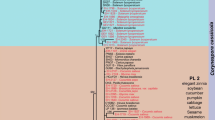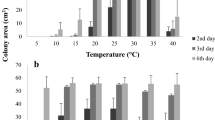Abstract
The main causal agent of early blight, the noxious disease of solanaceous crops, is generally considered to be Alternaria solani Sorauer (in a broad sense). However, heterogeneity in many morphological features of this pathogen has been noted suggesting that the disease may not be caused by a single species. Recent research has revealed that several large-spored Alternaria species may cause disease of potato and tomato including A. solani sensu stricto and A. tomatophila. The goal of our research was to compare Russian large-spored Alternaria isolates from tomato and potato to test the hypothesis that early blight of tomato and potato are caused by different species. Cluster analysis of genetic distances estimated from 12 polymorphic molecular markers (universally primed-polymerase chain reaction and randomly amplified polymorphic DNA) revealed two groups of isolates accepted here as A. solani and A. tomatophila that were supported by morphology and host plant association. Differentiation of species was supported by phylogeny derived from the DNA sequences of a portion of the Alt a1, gpd and calmodulin genes. Species-specific primers based on the Alt a1 and calmodulin gene sequences for both species were designed. Under laboratory conditions, A. solani isolates were equally aggressive on both tomato and potato, whereas A. tomatophila was highly aggressive to tomato but only weakly aggressive to potato. In the field, A. solani was isolated from potato, tomato and from several wild potato species including S. schickii, S. papita and S. kurtzianum. The majority (90 %) of A. solani isolates carried the mating type locus 1 (MAT1) idiomorph MAT1-1 while the majority (88 %) of A. tomatophila isolates carried the MAT1-2 idiomorph.





Similar content being viewed by others
References
Adachi, Y., Watanabe, H., & Tsuge, T. (1996). Relationship between genetic polymorphisms and fungicide resistance within Alternaria alternata. Phytopathology, 86(11), 1248–1254.
Akhtar, K. P., Sarwar, N., Saleem, M. Y., & Asghar, M. (2011). Convolvulus arvensis, a new host for Alternaria solani causing early blight of Solanum lycopersicum in Pakistan. Australasian Plant Diseases Notes, 10, 1–3.
Andersen, B., Dongo, A., & Pryor, B. (2008). Secondary metabolite profile of Alternaria dauci, A. porri, A. solani and A. tomatophila. Mycological Research, 112(2), 241–250.
Aradhya, M. K., Chan, H. M., & Parfitt, D. E. (2001). Genetic variability in the pistachio late blight fungus Alternaria alternata. Mycological Research, 105(3), 300–306.
Ausubel, F. M., Brent, R., & Kingston, R. E. (2002). Short protocols in molecular biology (5th ed.). New York: Wiley.
Berbee, M. L., Pirseyedi, M., & Hubbard, S. (1999). Cochliobolus phylogenetics and the origin of known, highly virulent pathogens, inferred from ITS and glyceraldehydes-3-phosphate dehydrogenase gene sequences. Mycologia, 91(6), 964–977.
Berbee, M. L., Payne, B. P., Zhang, G., Roberts, R. G., & Turgeon, B. G. (2003). Shared ITS DNA substitutions in isolates of opposite mating type reveal a recombining history for three presumed asexual species in the filamentous ascomycete genus Alternaria. Mycological Research, 107(2), 169–182.
Bulat, S. A., Mironenko, N. V., & Zholkevich, I. G. (1995). Genetic structure of soil population of the fungus Fusarium oxysporum Schlechtend.: Fr.: molecular reidentification of the species and genetic differentiation of isolates using polymerase chain reaction with universal primers (UP-PCR). Molekulyarnaya Genetika, 3, 315–323 [in Russian].
Bulat, S. A., Lübeck, M., Alekhina, I. A., Funck, J. D., Knudsen, I. M. B., & Lübeck, P. S. (2000). Identification of a universally primed-PCR-derived sequence-characterized amplified region marker for an antagonistic strain of Clonostachys rosea and development of a strain-specific PCR detection assay. Applied and Environmental Microbiology, 66, 4758–4763.
Bussey, M., & Stevenson, W. (1991). A leaf disk assay for detecting resistance to early blight caused by Alternaria solani in juvenile potato plants. Plant Disease, 75(4), 385–390.
Chaerani, R., & Voorrips, R. E. (2006). Tomato early blight (Alternaria solani): the pathogen, genetics, and breeding for resistance. General Plant Pathology, 72, 335–347.
Dmitrieva, E. P. (1988). Development of the evaluation methods of potato resistance to the early blight and characteristics of potato by this trait. Ph.D. thesis. Moscow: Potato Research Institute.
Gannibal, P. B., & Kazartsev, I. A. (2013). Development of a PCR assay for amplification of mating-type loci of Alternaria spp. and related fungi. Czech Mycology, 65(1), 69–78.
Gannibal, P. B., Klemsdal, S. S., & Levitin, M. M. (2007). AFLP analysis of Russian Alternaria tenuissima populations from wheat kernels and other hosts. European Journal of Plant Pathology, 119(2), 175–182.
Henning, R. G., & Alexander, L. J. (1952). Evidence of existence of physiological races of Alternaria solani. Phytopathology, 42, 467.
Hong, S. G., Robert, A. C., Lawrence, C. B., & Pryor, B. M. (2005). Alt a 1 allergen homologs from Alternaria and related taxa: analysis of phylogenetic content and secondary structure. Fungal Genetics and Biology, 42, 119–129.
Ivanuk, V. G., & Palilova, A. N. (1996). Structure of Alternaria solani (Ell. et Mart.) Jones et Grout populations—the pathogen of potatoes alternariosis and its dynamic in Byelorussia. Mikologiya i Fitopatologiya, 30(3), 66–74 [in Russian].
Ivanyuk, V. G. (1983). Intraspecific variability of the causal agent of macrosporiosis of solanaceous crops and its practical importance. In: Variability of phytopathogenic microorganisms (pp. 208–214). Moscow: Kolos [in Russian].
Ivanyuk, V. G., Benadysev, S. A., & Zhuromskiy, G. K. (2003). Protection of potato from diseases, pests and weeds. Minsk: Belarusian Institute for Potato Breeding [in Russian].
Izquierdo, F. (1981). Evidencia de la existencia de razas fisiológicas de Alternaria solani en las plantaciones de tomate en Cuba. Ciencias Biológicas, 12(2), 223–233.
Kozlovsky, B. E., & Filippov, A. V. (2007). Alternariosis on potato becoming more noxious. Zaschita i Karantin Rasteniy, 5, 12–13 [in Russian].
Kumar, V., Haldar, S., Pandey, K. K., Singh, R. P., Singh, A. K., & Singh, P. C. (2007). Cultural, morphological, pathogenic and molecular variability amongst tomato isolates of Alternaria solani in India. World Journal of Microbiology and Biotechnology, 24(7), 1003–1009.
Lawrence, D. P., Gannibal, P. B., Peever, T. L., & Pryor, B. M. (2013). The Sections of Alternaria: formalizing species-group concepts. Mycologia, 105(3), 530–546.
Lourenço, V., Moya, A., González-Candelas, F., Carbone, I., Maffia, L. A., & Mizubuti, E. S. G. (2009). Molecular diversity and evolutionary processes of Alternaria solani in Brazil inferred using genealogical and coalescent approaches. Phytopathology, 99(6), 765–774.
Lübeck, P. S., Alekhina, I. A., Lübeck, M., & Bulat, S. A. (1999). UP-PCR genotype and rDNA analysis of Ascochyta pisi Lib. Journal of Phytopathology, 146(1), 51–55.
Martinez, S. P., Snowdon, R., & Pons-Kuhnemann, J. (2004). Variability of Cuban and international populations of Alternaria solani from different hosts and localities: AFLP genetic analysis. European Journal of Plant Pathology, 110(4), 399–409.
Mikhailova, L. A., Gogoleva, S. G., & Gultyaeva, E. I. (2002). The interactions of Bipolaris sorokiniana strains and wheat samples. Mikologiya i Fitopatologiya, 36(2), 63–66 [in Russian].
Morris, P. F., Connolly, M. S., & Clair, D. A. (2000). Genetic diversity of Alternaria alternata isolated from tomato in California assessed using RAPDs. Mycological Research, 104(3), 286–292.
Neergaard, P. (1945). Danish species of Alternaria and Stemphtlium. Taxonomy, parasitism, economical signification. Copenhagen: Munksgaard, Oxford University Press.
Orina, A. S., Gannibal, P. B., & Levitin, M. M. (2010). Specific diversity, biological characters and geography of Alternaria fungi associated with solanaceous plants. Mikologiya i Fitopatologiya, 44(2), 150–159 [in Russian].
Remneva, Z. I., & Ivanjuk, V. G. (1968). Intraspecific heterogeneity of Macrosporium solani Ell. et Mart. – causal organism of early spot of potato. Mikologiya i Fitopatologiya, 2(3), 202–209 [in Russian].
Rodrigues, T. T. M. S., Berbee, M. L., Simmons, E. G., Cardoso, C. R., Reis, A., Maffia, L. A., et al. (2010). First report of Alternaria tomatophila and A. grandis causing early blight on tomato and potato in Brazil. New Disease Reports, 22, 28.
Rotem, J. (1994). The genus Alternaria. St. Paul: APS Press.
Samson, R. A., Hoekstra, E. S., Frisvad, J. C., & Filtenborg, O. (2000). Introduction to food- and airborne fungi (6th ed.). Utrecht: Centraalbureau voor schimmelcultures.
Schneider, S., Roessli, D., & Excoffier, L. (2000). Arlequin ver. 2.000. A Software for population genetic data analysis. Geneva: Genetics and Biometry Laboratory, University of Geneva.
Sherf, A. F., & MacNab, A. A. (1986). Vegetable diseases and their control. New York: Wiley.
Simmons, E. G. (2000). Alternaria themes and variations (224–286). Mycotaxon, 75, 1–115.
Simmons, E. G. (2007). Alternaria: an identification manual. Utrecht: CBS.
Stamatakis, A. (2006). RAxML-VI-HPC: Maximum Likelihood-based Phylogenetic Analyses with Thousands of Taxa and Mixed Models. Bioinformatics, 22(21), 2688–2690.
Untergasser, A., Nijveen, H., Rao, X., Bisseling, T., Geurts, R., & Leunissen, J. A. M. (2007). Primer3Plus, an enhanced web interface to Primer3. Nucleic Acids Research, 35(suppl. 2), W71–W74.
van der Waals, J. E., Korsten, L., & Slippers, B. (2004). Genetic diversity among Alternaria solani isolates from potatoes in South Africa. Plant Disease, 88(9), 959–964.
Van de Peer, Y. & De Wachter, R. (1994). TREECON for Windows: a software package for the construction and drawing of evolutionary trees for the Microsoft Windows environment. Computer Applications in the Biosciences, 10, 569–570.
Weber, B., & Halterman, D. A. (2012). Analysis of genetic and pathogenic variation of Alternaria solani from a potato production region. European Journal of Plant Pathology, 134(4), 847–858.
Weir, T. L., Huff, D. R., Christ, B. J., & Romaine, C. P. (1998). RAPD-PCR analysis of genetic variation among isolates of Alternaria solani and Alternaria alternata from potato and tomato. Mycologia, 90(5), 813–821.
Williams, J. G. K., Kubelik, A. R., Livak, K. J., Rafalski, J. A., & Tingey, S. V. (1990). DNA polymorphisms amplified by arbitrary primers are useful as genetic markers. Nucleic Acids Research, 18(22), 6531–6535.
Wright, S. (1943). Isolation by distance. Genetics, 28, 114–138.
Acknowledgments
The authors are grateful to Dr. E. G. Simmons (Crawfordsville, IN, USA) for providing representative Alternaria cultures, to Dr. T. L. Peever (Pullman, WA, USA) for editing and thoughtful commenting on the draft of this manuscript and to Dr. I. A. Kazartsev and N. S. Pilshchikova for help with the DNA sequencing. This work was supported by the Russian Foundation for Basic Research (grant # 12-04-00677). Equipment of the Centre of Collective Use “Innovative Technologies of Plant Protection” was used.
Author information
Authors and Affiliations
Corresponding author
Rights and permissions
About this article
Cite this article
Gannibal, P.B., Orina, A.S., Mironenko, N.V. et al. Differentiation of the closely related species, Alternaria solani and A. tomatophila, by molecular and morphological features and aggressiveness. Eur J Plant Pathol 139, 609–623 (2014). https://doi.org/10.1007/s10658-014-0417-6
Accepted:
Published:
Issue Date:
DOI: https://doi.org/10.1007/s10658-014-0417-6




